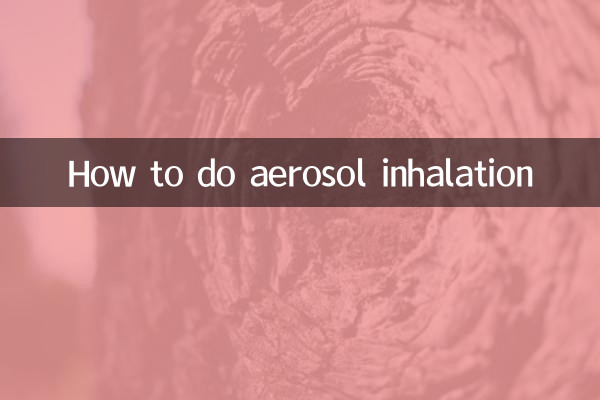How to do aerosol inhalation
Recently, aerosol inhalation, as a common treatment method for respiratory diseases, has become a hot topic again. Many parents and patients have questions about the operating procedures, precautions and applicable drugs for aerosol inhalation. This article will combine the hot content on the Internet in the past 10 days to provide you with a detailed analysis of the correct operation method of atomized inhalation.
1. Basic principles of aerosol inhalation

Aerosol inhalation converts drugs into tiny particles, which act directly on the respiratory tract and lungs to achieve rapid symptom relief. This method is suitable for respiratory diseases such as asthma, chronic obstructive pulmonary disease (COPD), and bronchitis.
2. Operation steps of aerosol inhalation
| steps | Specific operations |
|---|---|
| 1. Preparation | Wash your hands and check that nebulizers and medications are within their expiry date. |
| 2. Assemble the atomizer | Assemble the atomizer according to the instructions, making sure that all parts are connected tightly. |
| 3. Add medicine | Pour the medicine prescribed by the doctor into the atomizer cup according to the dosage. |
| 4. Start atomization | Connect the power or oxygen source, turn on the switch, and start inhaling. |
| 5. Inhalation process | Hold the mouthpiece or mask in your mouth and breathe slowly and deeply. |
| 6. End the operation | After inhaling the medication, turn off the device, clean the nebulizer and let it dry. |
3. Precautions for aerosol inhalation
1.Medication options:Drugs for aerosol inhalation must be prescribed by a doctor. Common drugs include bronchodilators, glucocorticoids, etc.
2.Operating environment:Aerosol inhalation should be performed in a quiet and clean environment to avoid cross-infection.
3.Inhalation time:The time for each aerosol inhalation is usually 10-15 minutes, and the specific time is adjusted according to the drug and condition.
4.Cleaning and disinfection:The atomizer should be cleaned promptly after use to avoid bacterial growth.
4. Frequently Asked Questions
| question | Answer |
|---|---|
| What are the side effects of aerosol inhalation? | A few patients may experience dry mouth, hoarseness, etc. Generally, no special treatment is required. |
| How do children cooperate with aerosol inhalation? | You can choose a face mask nebulizer, or do it when the child is quiet. |
| Can aerosol inhalation replace oral medication? | It cannot be completely replaced, and treatment options need to be selected according to the doctor’s recommendations. |
5. Recently popular topics related to aerosol inhalation
1.Home nebulizer options:Recently, many netizens have discussed how to choose a nebulizer suitable for home use, focusing on noise, portability and therapeutic effect.
2.Nebulization and COVID-19:Some recovering patients use aerosol inhalation to relieve respiratory symptoms, but strict disinfection is required.
3.Misunderstandings about aerosol inhalation in children:Many parents are worried about the side effects of hormonal inhalation, but in fact it is safe when used under the guidance of a doctor.
6. Summary
Nebulization inhalation is an effective treatment method for respiratory diseases, and correct operation and precautions are crucial. Through the introduction of this article, I hope you can master the correct method of atomized inhalation and use it rationally under the guidance of a doctor. If you feel unwell, seek medical advice promptly.

check the details

check the details